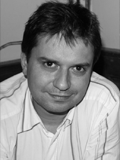GOTO Berlin is a vendor independent international software development conference with more that 60 top speakers and 600 attendees. The conference covers topics such as Java, Open Source, Agile, Architecture, Design, Web, Cloud, New Languages and Processes.
Francesco Cesarini, TweetFounder of Erlang Solutions & author of Erlang Programming

Biography: Francesco Cesarini
Francesco Cesarini is the founder and Technical Director of Erlang Solutions. He has used Erlang on a daily basis for almost 15 years, starting as an intern at Ericsson’s computer science laboratory, the birthplace of Erlang. He moved on to Ericsson’s Erlang training and consulting arm working on the first release of OTP, applying it to turnkey solutions and flagship telecom applications. In 1999, soon after Erlang was released as open source, he founded Erlang Solutions, who have become the world leaders in Erlang based consulting, contracting, training and systems development. Francesco has worked in major Erlang based projects both within and outside Ericsson, and as Technical Director, is currently leading the development and consulting teams at Erlang Solutions. He is also the co-author of Erlang Programming, a book published by O’Reilly and is currently co-authoring Designing For Scalability With Erlang/OTP. He lectures the graduate students at Oxford University.
Twitter: @FrancescoC
Presentation: TweetThinking in a Highly Concurrent, Mostly-functional Language
Yale Professor Alan Perlis once wrote, “A language that doesn’t affect the way you think about programming, is not worth knowing.” To really appreciate the power of the actor model, no matter if you are using Elixir, Go, Rust, AKKA or Erlang, you need to learn to think concurrently. Erlang has for decades been leading the way in concurrent thinking and developers from different communities and backgrounds have a lot to learn from its approach.
Through these case studies, we will describe how Erlang, and more specifically, concurrency was done in 1995 when the limit of processes was 30,000, with an evolution as to how concurrency is used and applied today, when the limit of simultaneous processes in in the magnitude of millions per virtual machine. Through this talk, we will illustrate by example how embracing the Erlang way of thinking about problems leads to scalable and fault-tolerant designs.
